miRNA Profiling and Its Role in Multi-Omics Regulatory Networks Connected with Somaclonal Variation in Cucumber (Cucumis sativus L.)
Abstract
1. Introduction
2. Results
2.1. Overall Scheme of the Analysis
2.2. Overview of sRNA Sequencing
2.3. miRNA Identification and Differential Expression
2.4. Identification of Target Genes
2.5. Target Expression Profiles Based on Transcriptome Data
2.6. Modeling of Interaction Regulatory Networks
3. Discussion
4. Materials and Methods
4.1. Plant Material
4.2. Isolation of RNA, Library Construction and High-Throughput Sequencing of the Small RNA Fraction
4.3. Bioinformatic Assessment of the miRNA and Targets: Degradome Verification
4.4. Integration of Multi Omics Data
4.5. qPCR Analysis of Expression of miRNA and Their Target Genes
5. Conclusions
Supplementary Materials
Author Contributions
Funding
Institutional Review Board Statement
Informed Consent Statement
Data Availability Statement
Acknowledgments
Conflicts of Interest
References
- Larkin, P.J.; Scowcroft, W.R. Somaclonal variation—A novel source of variability from cell cultures for plant improvment. Theor. Appl. Genet. 1981, 60, 197–214. [Google Scholar] [CrossRef] [PubMed]
- Kaeppler, S.M.; Phillips, R.L.; Olhoft, P. Molecular basis of heritable tissue culture—Induced variation in plants. In Somaclonal Variation and Induced Mutation in Crop Improvement; Jain, S.M., Brar, D.S., Ahloowalia, B.S., Eds.; Kluwer Academic Publishers: Dordrecht, The Netherlands, 1998; pp. 465–484. [Google Scholar]
- Zhang, D.; Wang, Z.; Wang, N.; Gao, Y.; Liu, Y.; Wu, Y.; Bai, Y.; Zhang, Z.; Lin, X.; Dong, Y.; et al. Tissue culture-induced heritable genomic variation in rice, and their phenotypic implications. PLoS ONE 2014, 9, e96879. [Google Scholar] [CrossRef] [PubMed]
- Azizi, P.; Hanafi, M.M.; Sahebi, M.; Harikrishna, J.A.; Taheri, S.; Yassoralipour, A.; Nasehi, A. Epigenetic changes and their relationship to somaclonal variation: A need to monitor the micropropagation of plantation crops. Funct. Plant Biol. 2020, 47, 508–523. [Google Scholar] [CrossRef] [PubMed]
- Jiang, C.; Mithani, A.; Gan, X.; Belfield, E.J.; Klingler, J.P.; Zhu, J.K.; Ragoussis, J.; Mott, R.; Harberd, N.P. Regenerant Arabidopsis lineages display a distinct genome-wide spectrum of mutations conferring variant phenotypes. Curr. Biol. 2011, 21, 1385–1390. [Google Scholar] [CrossRef] [PubMed]
- Yadav, C.B.; Pandey, G.; Muthamilarasan, M.; Prasad, M. Epigenetics and Epigenomics of Plants. Adv. Biochem. Eng. Biotechnol. 2018, 164, 237–261. [Google Scholar] [PubMed]
- Lee, M.; Phillips, R.L. The Chromosomal Basis of Somaclonal Variation. Annu. Rev. Plant Physiol. Plant Mol. Biol. 1988, 39, 413–437. [Google Scholar] [CrossRef]
- Ong-Abdullah, M.; Ordway, J.M.; Jiang, N.; Ooi, S.E.; Kok, S.Y.; Sarpan, N.; Azimi, N.; Hashim, A.T.; Ishak, Z.Z.; Rosli, S.K.; et al. Loss of Karma transposon methylation underlies the mantled somaclonal variant of oil palm. Nature 2015, 525, 533–537. [Google Scholar] [CrossRef]
- Miyao, A.; Nakagome, M.; Ohnuma, T.; Yamagata, H.; Kanamori, H.; Katayose, Y.; Takahashi, A.; Matsumoto, T.; Hirochika, H. Molecular Spectrum of Somaclonal Variation in Regenerated Rice Revealed by Whole-Genome Sequencing. Plant Cell Physiol. 2012, 53, 256–264. [Google Scholar] [CrossRef]
- Bednarek, P.T.; Orłowska, R.; Koebner, R.M.D.; Zimny, J. Quantification of the tissue-culture induced variation in barley (Hordeum vulgare L.). BMC Plant Biol. 2007, 7, 10. [Google Scholar] [CrossRef][Green Version]
- Linacero, R.; Rueda, J.; Esquivel, E.; Bellido, A.; Domingo, A.; Vázquez, A.M. Genetic and epigenetic relationship in rye, Secale cereale L., somaclonal variation within somatic embryo-derived plants. Vitr. Cell Dev. Biol. Plant 2011, 47, 618–628. [Google Scholar] [CrossRef]
- Krishna, H.; Alizadeh, M.; Singh, D.; Singh, U.; Chauhan, N.; Eftekhari, M.; Sadh, R.K. Somaclonal variations and their applications in horticultural crops improvement. 3 Biotech 2016, 6, 54. [Google Scholar] [CrossRef]
- Smulders, M.J.M.; de Klerk, G.J. Epigenetics in plant tissue culture. Plant Growth Regul. 2011, 63, 137–146. [Google Scholar] [CrossRef]
- Evans, D.A. Somaclonal variation—Genetic basis and breeding applications. Trends Genet. 1989, 5, 46–50. [Google Scholar] [CrossRef]
- González, G.A.; Pacheco, M.G.; Oneto, C.D.; Etchart, V.J.; Kandus, M.V.; Salerno, J.C.; Eyherabide, G.; Presello, D.; Lewi, D.M. Somatic embryogenesis and plant regeneration capacity in Argentinean maize (Zea mays L.) inbred lines. Electron. J. Biotechnol. 2012, 15, 9. [Google Scholar]
- Meng, L.; Zhang, S.; Lemaux, P.G. Toward molecular understanding of in vitro and in planta shoot organogenesis. CRC Crit. Rev. Plant Sci. 2010, 29, 108–122. [Google Scholar] [CrossRef]
- Shahid, S.; Axtell, M.J. Identification and annotation of small RNA genes using ShortStack. Methods 2014, 67, 20–27. [Google Scholar] [CrossRef]
- Axtell, M.J.; Meyers, B.C. Revisiting criteria for plant microRNA annotation in the era of big data. Plant Cell 2018, 30, 272–284. [Google Scholar] [CrossRef]
- Vashisht, D.; Nodine, M.D. MicroRNA functions in plant embryos. Biochem. Soc. Trans. 2014, 42, 352–357. [Google Scholar] [CrossRef]
- Singh, A.; Gautam, V.; Singh, S.; Sarkar Das, S.; Verma, S.; Mishra, V.; Mukherjee, S.; Sarkar, A.K. Plant small RNAs: Advancement in the understanding of biogenesis and role in plant development. Planta 2018, 248, 545–558. [Google Scholar] [CrossRef]
- Zhang, M.; Dong, Y.; Nie, L.; Lu, M.; Fu, C.; Yu, L. High-throughput sequencing reveals miRNA effects on the primary and secondary production properties in long-term subcultured Taxus cells. Front. Plant Sci. 2015, 6, 604. [Google Scholar] [CrossRef]
- Chen, Y.; Zhang, M.; Jin, X.; Tao, H.; Wang, Y.; Peng, B.; Fu, C.; Yu, L. Transcriptional reprogramming strategies and miRNA-mediated regulation networks of Taxus media induced into callus cells from tissues. BMC Genom. 2020, 21, 168. [Google Scholar] [CrossRef]
- Rodriguez-Enriquez, J.; Dickinson, H.G.; Grant-Downton, R.T. MicroRNA misregulation: An overlooked factor generating somaclonal variation? Trends Plant Sci. 2011, 16, 242–248. [Google Scholar] [CrossRef]
- Li, H.; Zhao, X.; Dai, H.; Wu, W.; Mao, W.; Zhang, Z. Tissue culture responsive microRNAs in strawberry. Plant Mol. Biol. Rep. 2012, 30, 1047–1054. [Google Scholar] [CrossRef]
- Morin, R.D.; Aksay, G.; Dolgosheina, E.; Ebhardt, H.A.; Magrini, V.; Mardis, E.R.; Sahinalp, S.C.; Unrau, P.J. Comparative analysis of the small RNA transcriptomes of Pinus contorta and Oryza Sativa. Genome Res. 2008, 18, 571–584. [Google Scholar] [CrossRef]
- Ghani, M.A.; Li, J.; Rao, L.; Raza, M.A.; Cao, L.; Yu, N.; Zou, X.; Chen, L. The role of small RNAs in wide hybridisation and allopolyploidisation between Brassica rapa and Brassica nigra. BMC Plant Biol. 2014, 14, 272. [Google Scholar] [CrossRef]
- Ha, M.; Pang, M.; Agarwal, V.; Chen, Z.J. Interspecies regulation of microRNAs and their targets. Biochim. Biophys. Acta 2008, 1779, 735–742. [Google Scholar] [CrossRef]
- Moturu, T.R.; Sinha, S.; Salava, H.; Thula, S.; Nodzyński, T.; Vařeková, R.S.; Friml, J.; Simon, S. Molecular Evolution and Diversification of Proteins Involved in miRNA Maturation Pathway. Plants 2020, 9, 299. [Google Scholar] [CrossRef]
- Peng, C.; Chen, X.; Wang, X.; Xu, X.; Wei, W.; Wang, C.; Xu, J. Comparative analysis of miRNA expression profiles in transgenic and non-transgenic rice using miRNA-Seq. Sci. Rep. 2018, 8, 338. [Google Scholar] [CrossRef]
- Szwacka, M.; Pawełkowicz, M.; Skarzyńska, A.; Osipowski, P.; Wojcieszek, M.; Przybecki, Z.; Pląder, W. Biological significance, computational analysis, and applications of plant microRNAs. Acta Physiol. Plant. 2018, 40, 146. [Google Scholar] [CrossRef]
- Sun, C.; Zhao, Q.; Liu, D.D.; You, C.X.; Hao, Y.J. Ectopic expression of the apple Md-miRNA156h gene regulates flower and fruit development in Arabidopsis. Plant Cell Tissue Org. 2013, 112, 343–351. [Google Scholar] [CrossRef]
- Tang, F.; Wei, H.R.; Zhao, S.T.; Wang, L.J.; Zheng, H.Q.; Lu, M.Z. Identification of microRNAs involved in regeneration of the secondary vascular system in Populus tomentosa Carr. Front. Plant Sci. 2016, 7, 724–741. [Google Scholar] [CrossRef] [PubMed]
- Zhao, Z.; Xue, Y.D.; Yang, H.L.; Li, H.M.; Sun, G.Y.; Zhao, X.F.; Ding, D.; Tang, J.H. Genome-wide identification of miRNAs and their targets involved in the developing internodes under maize ears by responding to hormone signaling. PLoS ONE 2016, 11, e0164026. [Google Scholar] [CrossRef] [PubMed]
- Ding, D.; Zhang, L.F.; Wang, H.; Liu, Z.J.; Zhang, Z.X.; Zheng, Y.L. Differential expression of miRNAs in response to salt stress in maize roots. Ann. Bot. 2009, 103, 29–38. [Google Scholar] [CrossRef] [PubMed]
- Kantar, M.; Lucas, S.J.; Budak, H. miRNA expression patterns of Triticum dicoccoides in response to shock drought stress. Planta 2011, 233, 471–484. [Google Scholar] [CrossRef] [PubMed]
- Martinez, G.; Forment, J.; Llave, C.; Pallas, V.; Gomez, G. High-throughput sequencing, characterization and detection of new and conserved cucumber miRNAs. PLoS ONE 2011, 6, e19523. [Google Scholar] [CrossRef]
- Mao, W.; Li, Z.; Xia, X.; Li, Y.; Yu, J. A combined approach of high-throughput sequencing and degradome analysis reveals tissue specific expression of microRNAs and their targets in cucumber. PLoS ONE 2012, 7, e33040. [Google Scholar]
- Ling, J.; Luo, Z.; Liu, F.; Mao, Z.; Yang, Y.; Xie, B. Genome-wide analysis of microRNA targeting impacted by SNPs in cucumber genome. BMC Genom. 2017, 18, 275. [Google Scholar] [CrossRef]
- Sun, Y.; Luo, W.; Chang, H.; Li, Z.; Zhou, J.; Li, X.; Zheng, J.; Hao, M. Identification of miRNAs and Their Target Genes Involved in Cucumber Fruit Expansion Using Small RNA and Degradome Sequencing. Biomolecules 2019, 9, 483. [Google Scholar] [CrossRef]
- Skarzyńska, A.; Pawełkowicz, M.; Pląder, W. Genome-wide discovery of DNA variants in cucumber somaclonal lines. Gene 2020, 736, 144412. [Google Scholar] [CrossRef]
- Pawełkowicz, M.E.; Skarzyńska, A.; Mróz, T.; Bystrzycki, E.; Pląder, W. Molecular insight into somaclonal variation phenomena from transcriptome profiling of cucumber (Cucumis sativus L.) lines. Plant Cell Tissue Organ Cult. 2021, 145, 239–259. [Google Scholar] [CrossRef]
- Salmena, L.; Poliseno, L.; Tay, Y.; Kats, L.; Pandolfi, P.P. A ceRNA hypothesis: The Rosetta Stone of a hidden RNA language? Cell 2011, 14, 353–358. [Google Scholar] [CrossRef]
- Yang, X.; Wang, L.; Yuan, D.; Lindsey, K.; Zhang, X. Small RNA and degradome sequencing reveal complex miRNA regulation during cotton somatic embryogenesis. J. Exp. Bot. 2013, 64, 1521–1536. [Google Scholar] [CrossRef]
- Wang, Q.; Zhang, B. MicroRNAs in cotton: An open world needs more exploration. Planta 2015, 241, 1303–1312. [Google Scholar] [CrossRef]
- Barabási, A.L. The network takeover. Nat. Phys. 2012, 8, 14. [Google Scholar] [CrossRef]
- Boccaletti, S.; Latora, V.; Moreno, Y.; Chavez, M.; Hwang, D.U. Complex networks: Structure and dynamics. Phys. Rep. 2006, 424, 175–308. [Google Scholar] [CrossRef]
- Newman, M.E.J. Networks: An Introduction; Oxford University Press: Oxford, UK, 2010. [Google Scholar]
- Smith, K.M. On neighbourhood degree sequences of complex networks. Sci. Rep. 2019, 9, 8340. [Google Scholar] [CrossRef]
- Shepherd, V.A. The cytomatrix as a cooperative system of macromolecular and water networks. Curr. Top. Dev. Biol. 2006, 75, 171–223. [Google Scholar]
- Chen, Y.; Weckwerth, W. Mass spectrometry untangles plant membrane protein signaling networks. Trends Plant Sci. 2020, 25, 930–940. [Google Scholar] [CrossRef]
- Salih, H.; Gong, W.; He, S.; Sun, G.; Sun, J.; Du, X. Genome-wide characterization and expression analysis of MYB transcription factors in Gossypium hirsutum. BMC Genet. 2016, 17, 129. [Google Scholar] [CrossRef]
- Orenstein, Y.; Shamir, R. Modeling protein–DNA binding via high-throughput in vitro technologies. Brief. Funct. Genom. 2017, 16, 171–180. [Google Scholar]
- Boeva, V. Analysis of genomic sequence motifs for deciphering transcription factor binding and transcriptional regulation in eukaryotic cells. Front. Genet. 2016, 7, 24. [Google Scholar] [CrossRef] [PubMed]
- Samad, A.F.A.; Sajad, M.; Nazaruddin, N.; Fauzi, I.A.; Murad, A.M.A.; Zainal, Z.; Ismail, I. MicroRNA and Transcription Factor: Key Players in Plant Regulatory Network. Front. Plant Sci. 2017, 8, 565. [Google Scholar] [CrossRef] [PubMed]
- Jones-Rhoades, M.W.; Bartel, D.P. Computational identification of plant microRNAs and their targets, including a stress-induced miRNA. Mol. Cell 2004, 14, 787–799. [Google Scholar] [CrossRef] [PubMed]
- Xu, G.; Ma, H.; Nei, M.; Kong, H. Evolution of F-box genes in plants: Different modes of sequence divergence and their relationships with functional diversification. Proc. Natl. Acad. Sci. USA 2009, 106, 835–840. [Google Scholar] [CrossRef]
- Zhang, T.; Lv, W.; Zhang, H.; Ma, L.; Li, P.; Ge, L.; Li, G. Genome-wide analysis of the basic Helix-Loop-Helix (bHLH) transcription factor family in maize. BMC Plant Biol. 2018, 18, 235. [Google Scholar] [CrossRef]
- Garcia-Mas, J.; Benjak, A.; Sanseverino, W.; Bourgeois, M.; Mir, G.; Gonzalez, V.M.; Henaff, E.; Camara, F.; Cozzuto, L.; Lowy, E.; et al. Lorent The genome of melon (Cucumis melo L.). Proc. Natl. Acad. Sci. USA 2012, 109, 11872–11877. [Google Scholar] [CrossRef]
- Xu, M.; Hu, T.; Zhao, J.; Park, M.Y.; Earley, K.W.; Wu, G.; Yang, L.; Poethig, R.S. Developmental Functions of miR156-Regulated SQUAMOSA PROMOTER BINDING PROTEIN-LIKE (SPL) Genes in Arabidopsis thaliana. PLoS Genet. 2016, 12, e1006263. [Google Scholar] [CrossRef]
- Long, J.M.; Liu, C.Y.; Feng, M.Q.; Liu, Y.; Wu, X.M.; Guo, W.W. MiR156-SPL modules regulate induction of somatic embryogenesis in citrus callus. J. Exp. Bot. 2018, 69, 2979–2993. [Google Scholar] [CrossRef]
- Rhoades, M.W.; Reinhart, B.J.; Lim, L.P.; Burge, C.B.; Bartel, B.; Bartel, D.P. Prediction of plant microRNA targets. Cell 2002, 110, 513–520. [Google Scholar] [CrossRef]
- Gonzalez-Ibeas, D.; Blanca, J.; Donaire, L.; Saladié, M.; Mascarell-Creus, A.; Cano-Delgado, A.; Garcia-Mas, J.; Llave, C.; Aranda, M.A. Analysis of the melon (Cucumis melo) small RNAome by high-throughput pyrosequencing. BMC Genom. 2011, 12, 393. [Google Scholar] [CrossRef]
- Laufs, P. MicroRNA regulation of the CUC genes is required for boundary size control in Arabidopsis meristems. Development 2004, 131, 4311–4322. [Google Scholar] [CrossRef]
- Ikeda, M.; Ohme-Takagi, M. TCPs, WUSs, and WINDs: Families of transcription factors that regulate shoot meristem formation, stem cell maintenance, and somatic cell differentiation. Front. Plant Sci. 2014, 5, 427. [Google Scholar] [CrossRef]
- Rodriguez, R.E.; Ercoli, M.F.; Debernardi, J.M.; Breakfield, N.W.; Mecchia, M.A.; Sabatini, M.; Cools, T.; De Veylder, L.L.; Benfey, P.N.; Palatnik, J.F. MicroRNA miR396 regulates the switch between stem cells and transit-amplifying cells in Arabidopsis roots. Plant Cell 2015, 27, 3354–3366. [Google Scholar] [CrossRef]
- Budak, H.; Kantar, M.; Bulut, R.; Akpinar, B.A. Stress responsive miRNAs and isomiRs in cereals. Plant Sci. 2015, 235, 1–13. [Google Scholar] [CrossRef]
- Miguel, C.; Marum, L. An epigenetic view of plant cells cultured in vitro: Somaclonal variation and beyond. J. Exp. Bot. 2011, 62, 3713–3725. [Google Scholar] [CrossRef]
- Ranghoo-Sanmukhiya, V.M. Somaclonal variation and methods used for its detection. In Propagation and Genetic Manipulation of Plants, 1st ed.; Siddique, I., Ed.; Springer Pte Ltd.: Singapore, 2021; Volume 1, pp. 1–19. [Google Scholar]
- Malepszy, S.; Burza, W.; Smiech, M. Characterization of a cucumber (Cucumis sativus L.) somaclonal variant with paternal inheritance. J. Appl. Genet. 1996, 1, 65–78. [Google Scholar]
- Bartoszewski, G.; Malepszy, S.; Havey, M.J. Mosaic (MSC) cucumbers regenerated from independent cell cultures possess different mitochondrial rearrangements. Curr. Genet. 2004, 45, 45–53. [Google Scholar] [CrossRef]
- Lilly, J.W.; Bartoszewski, G.; Malepszy, S.; Havey, M.J. A major deletion in the cucumber mitochondrial genome sorts with the MSC phenotype. Curr. Genet. 2001, 40, 144–151. [Google Scholar] [CrossRef]
- Plader, W.; Malepszy, S.; Burza, W.; Rusinowski, Z. The relationship between the regeneration system and genetic variability in the cucumber (Cucumis sativus L.). Euphytica 1998, 103, 9–15. [Google Scholar] [CrossRef]
- Ładyżyński, M.; Burza, W.; Malepszy, S. Relationship between somaclonal variation and type of culture in cucumber. Euphytica 2002, 125, 349–356. [Google Scholar] [CrossRef]
- FastQC Software. Available online: https://www.bioinformatics.babraham.ac.uk/projects/fastqc/ (accessed on 6 June 2021).
- Altschul, S.F.; Gish, W.; Miller, W.; Myers, E.W.; Lipman, D.J. Basic local alignment search tool. J. Mol. Biol. 1990, 215, 403–410. [Google Scholar] [CrossRef]
- Kozomara, A.; Griffiths-Jones, S. miRBase: Annotating high confidence microRNAs using deep sequencing data. Nucleic Acids Res. 2014, 42, 68–73. [Google Scholar] [CrossRef]
- Love, M.I.; Huber, W.; Anders, S. Moderated estimation of fold change and dispersion for RNAseq data with DESeq2. Genome Biol. 2014, 15, 550. [Google Scholar] [CrossRef]
- psRNA Target Software. Available online: http://plantgrn.noble.org/psRNATarget/ (accessed on 6 June 2021).
- Götz, S.; Garcia-Gomez, J.M.; Terol, J.; Williams, T.D.; Nagaraj, S.H.; Nueda, M.J.; Robles, M.; Talon, M.; Dopazo, J.; Conesa, A. High-throughput functional annotation and data mining with the Blast2GO suite. Nucleic Acids Res. 2008, 36, 3420–3435. [Google Scholar] [CrossRef]
- RNA Folder Software. Available online: http://www.ncrnalab.dk/#rnafolder/rnafolder.php (accessed on 26 April 2021).
- Zhang, K.; He, S.; Sui, Y.; Gao, Q.; Jia, S.; Lu, X.; Jia, L. Genome-Wide Characterization of HSP90 Gene Family in Cucumber and Their Potential Roles in Response to Abiotic and Biotic Stresses. Front. Genet. 2021, 12, 584886. [Google Scholar] [CrossRef]
- Zhang, X.; Lai, Y.; Zhang, W.; Ahmad, J.; Qiu, Y.; Zhang, X.; Duan, M.; Liu, T.; Song, J.; Wang, S.; et al. MicroRNAs and their targets in cucumber shoot apices in response to temperature and photoperiod. BMC Genom. 2018, 19, 819. [Google Scholar] [CrossRef]
- Folkes, L.; Moxon, S.; Woolfenden, H.C.; Stocks, M.B.; Szittya, G.; Dalmay, T.; Moulton, V. PAREsnip: A tool for rapid genome-wide discovery of small RNA/target interactions evidenced through degradome sequencing. Nucleic Acids Res. 2012, 40, e103. [Google Scholar] [CrossRef]
- Osipowski, P.; Pawełkowicz, M.; Wojcieszek, M.; Skarzyńska, A.; Przybecki, Z.; Pląder, W. A high-quality cucumber genome assembly enhances computational comparative genomics. Mol. Genet. Genom. 2020, 295, 177–193. [Google Scholar] [CrossRef]
- Szklarczyk, D.; Morris, J.H.; Cook, H.; Kuhn, M.; Wyder, S.; Simonovic, M.; Santos, A.; Doncheva, N.T.; Roth, A.; Bork, P.; et al. The STRING database in 2017: Quality-controlled protein–protein association networks, made broadly accessible. Nucleic Acids Res. 2016, 45, 362–365. [Google Scholar] [CrossRef]
- Cytoscape Software. Available online: https://cytoscape.org/ (accessed on 26 April 2021).
- Androvic, P.; Valihrach, L.; Elling, J.; Sjoback, R.; Kubista, M. Two-tailed RT-qPCR: A novel method for highly accurate miRNA quantification. Nucleic Acids Res. 2017, 45, e144. [Google Scholar] [CrossRef]
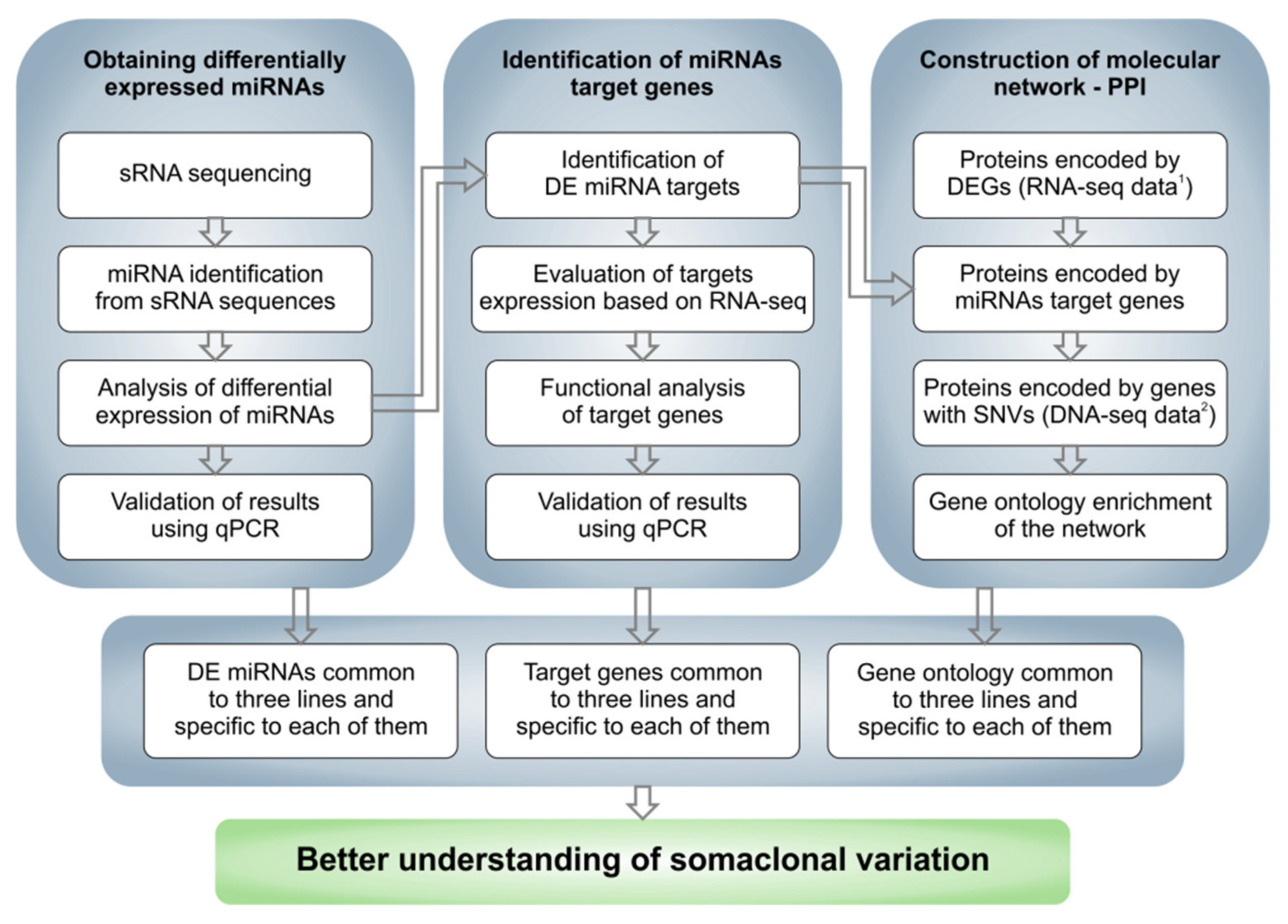

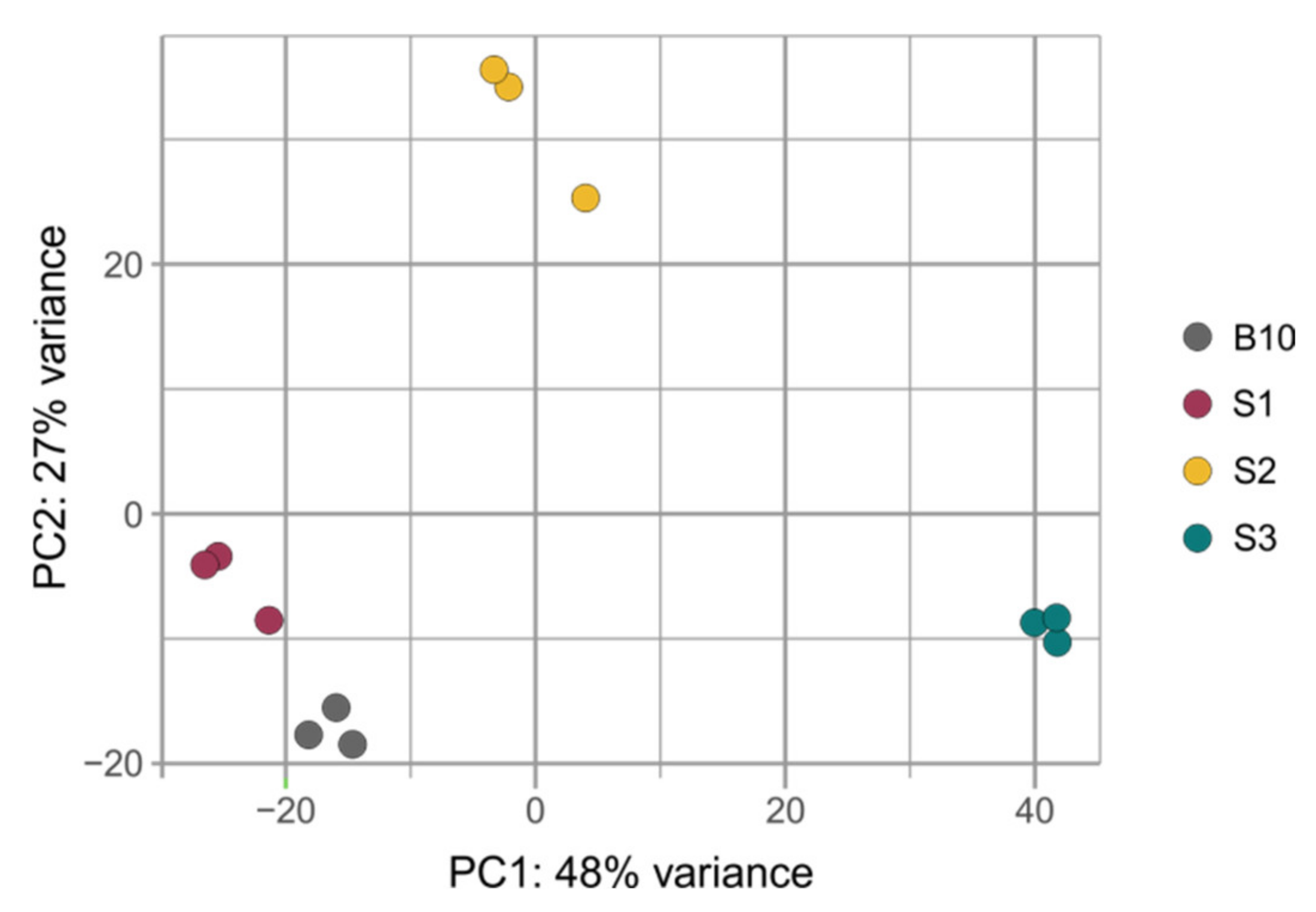
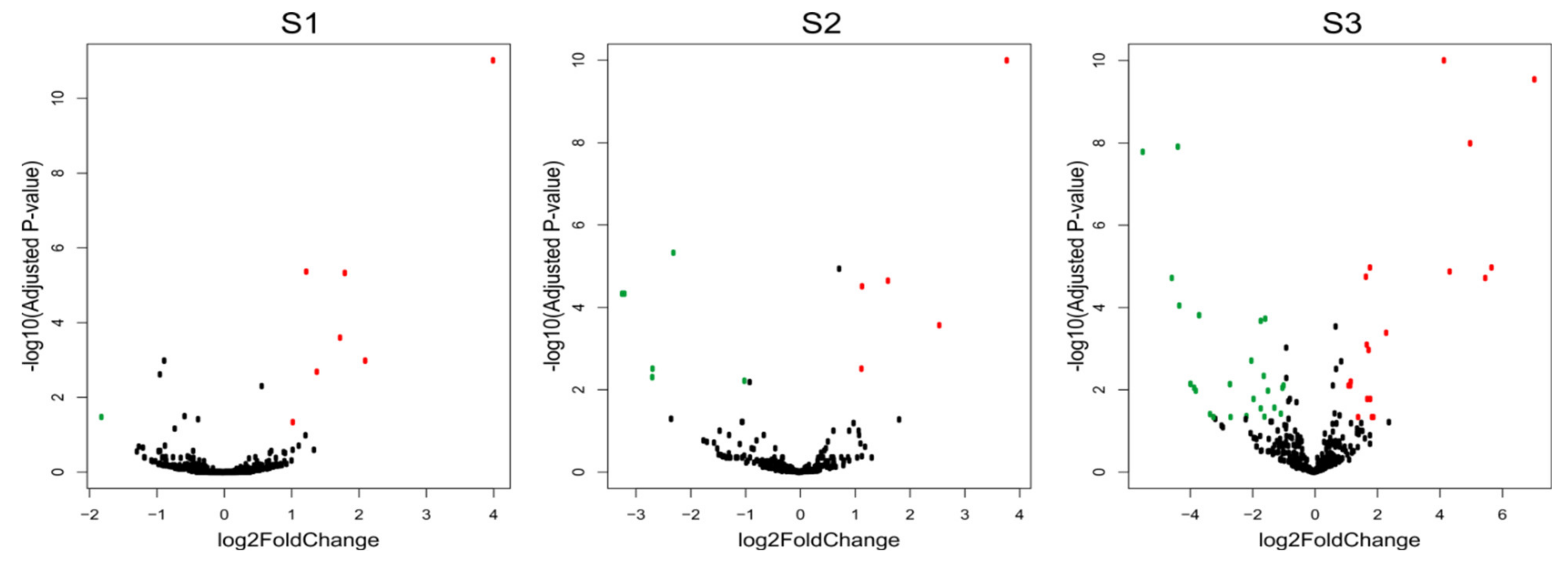
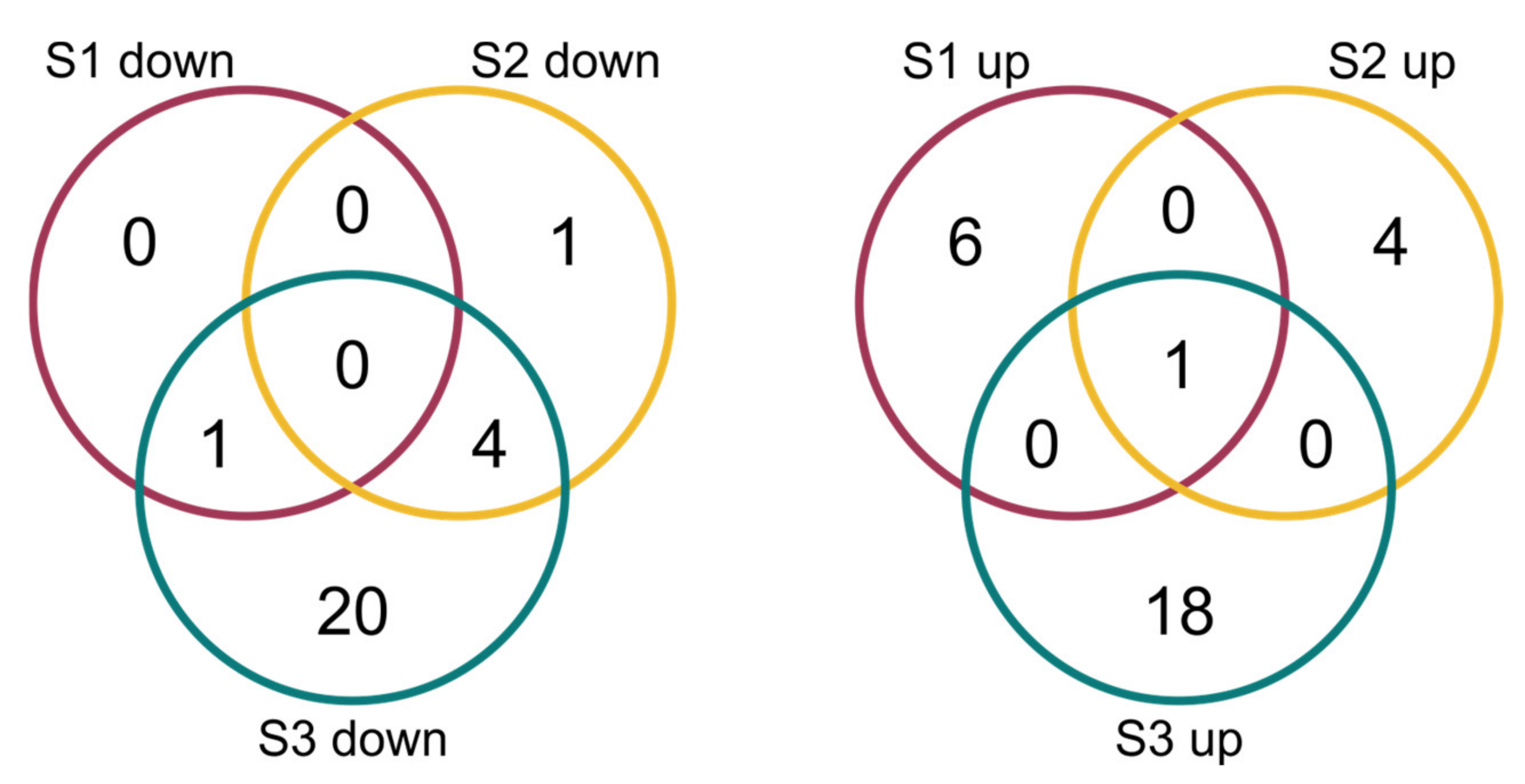
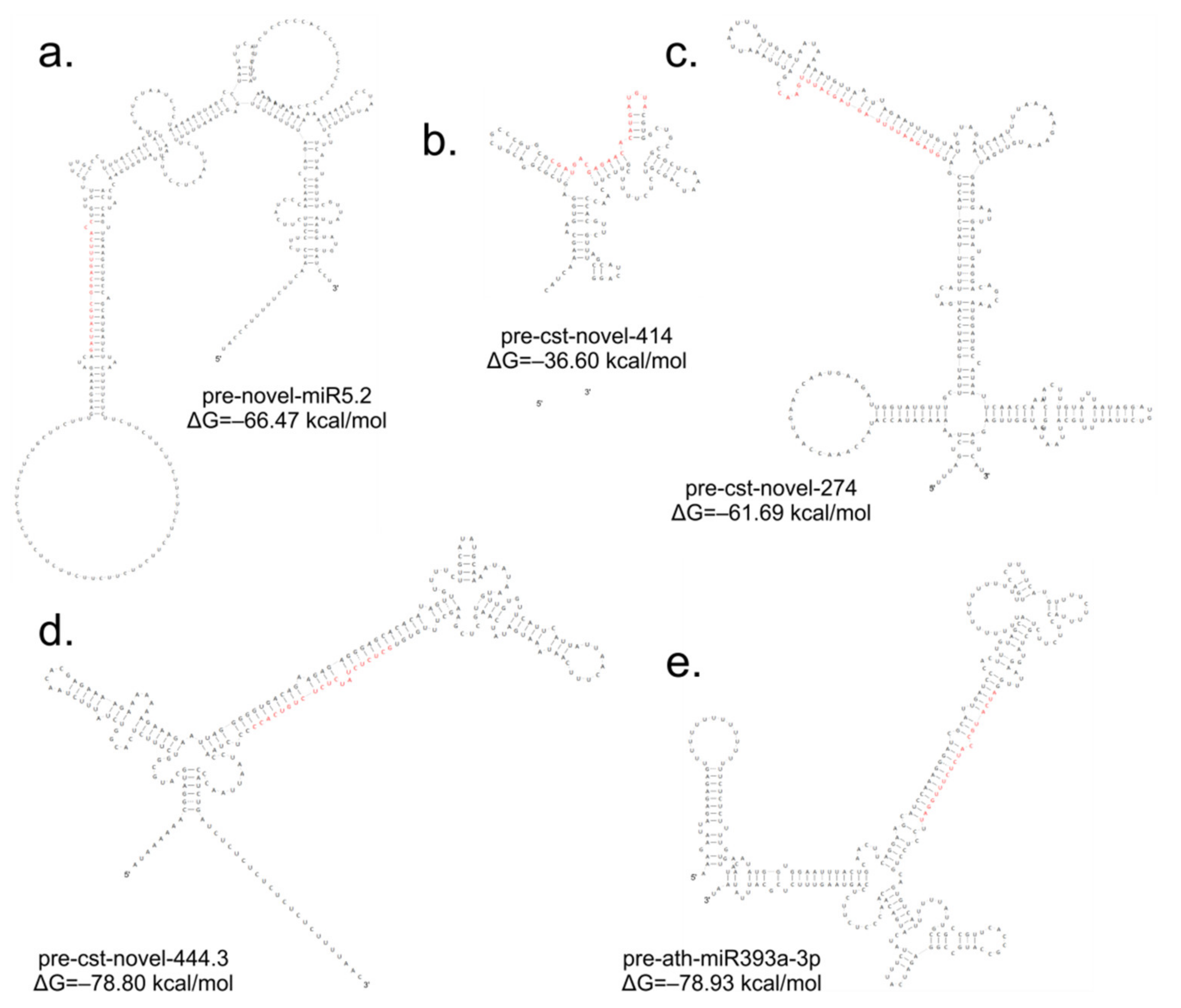
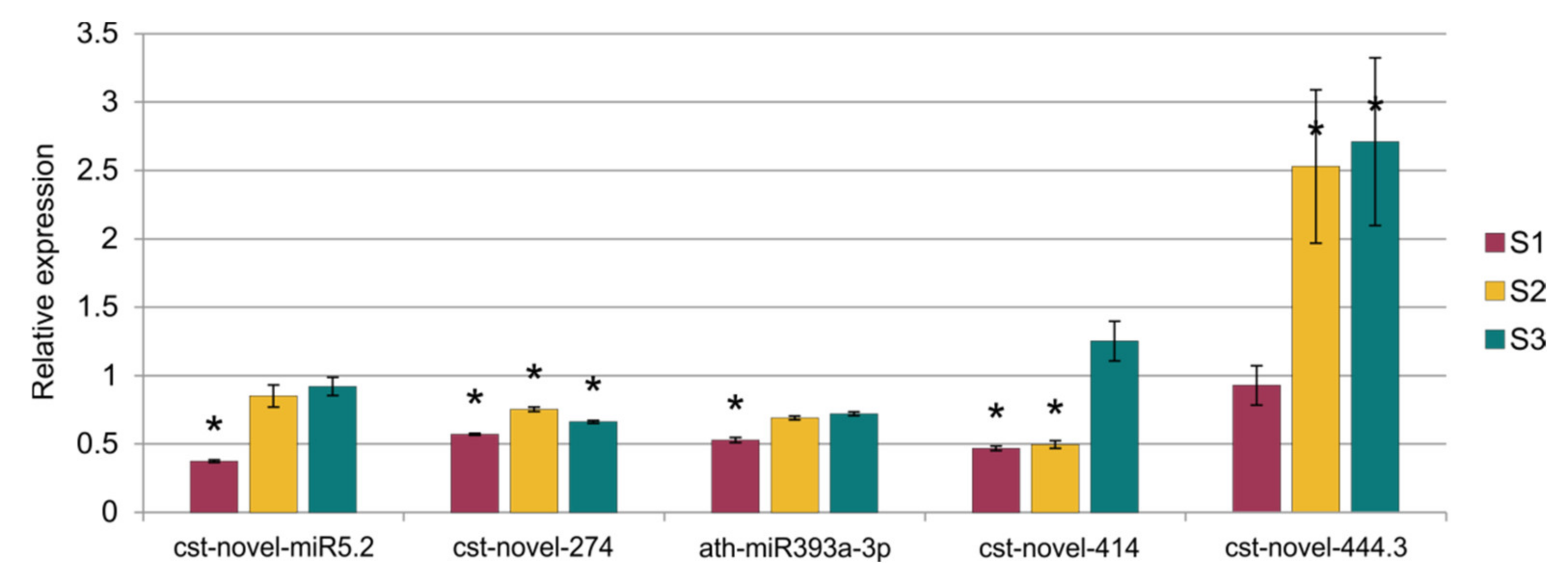
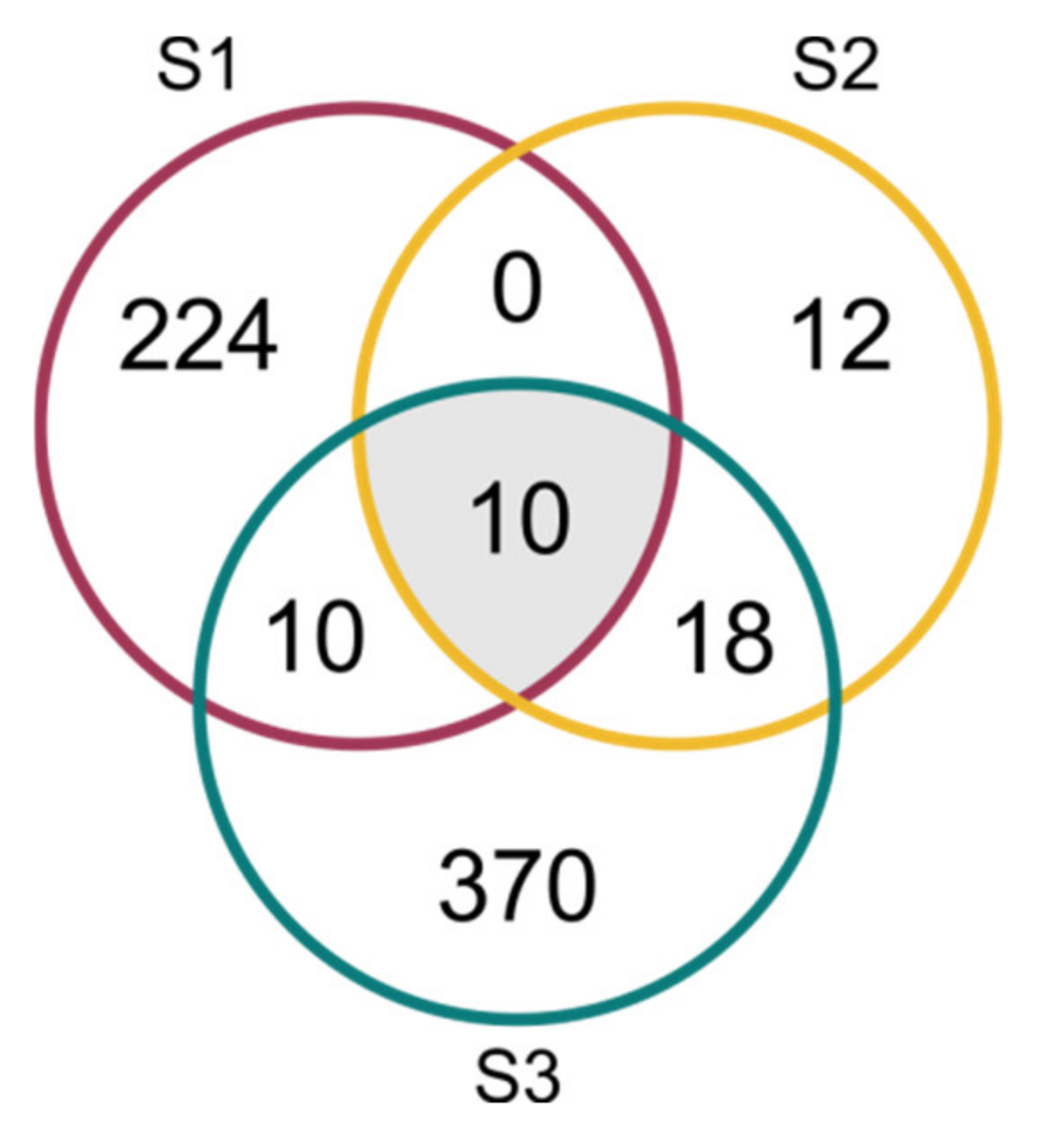
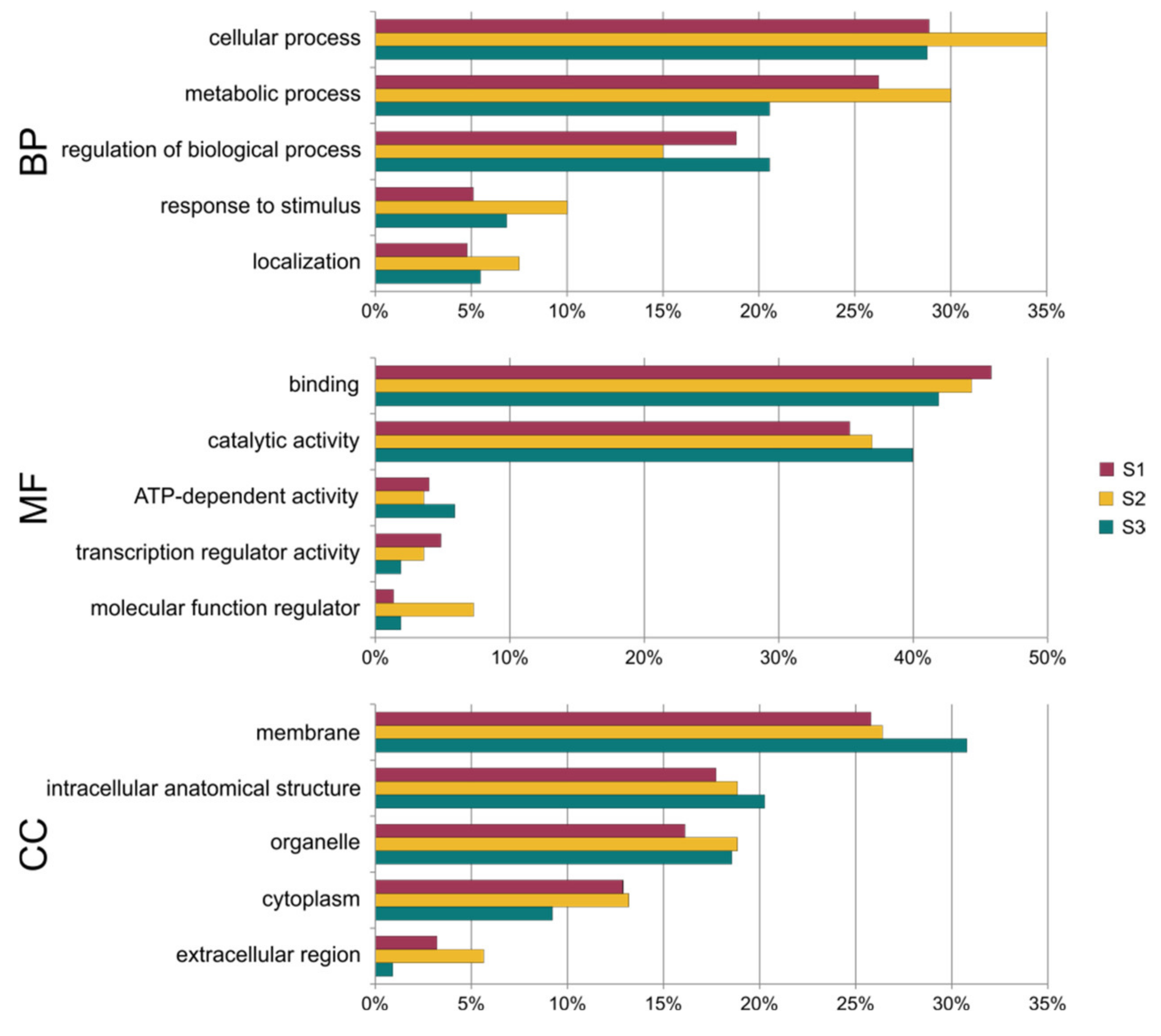
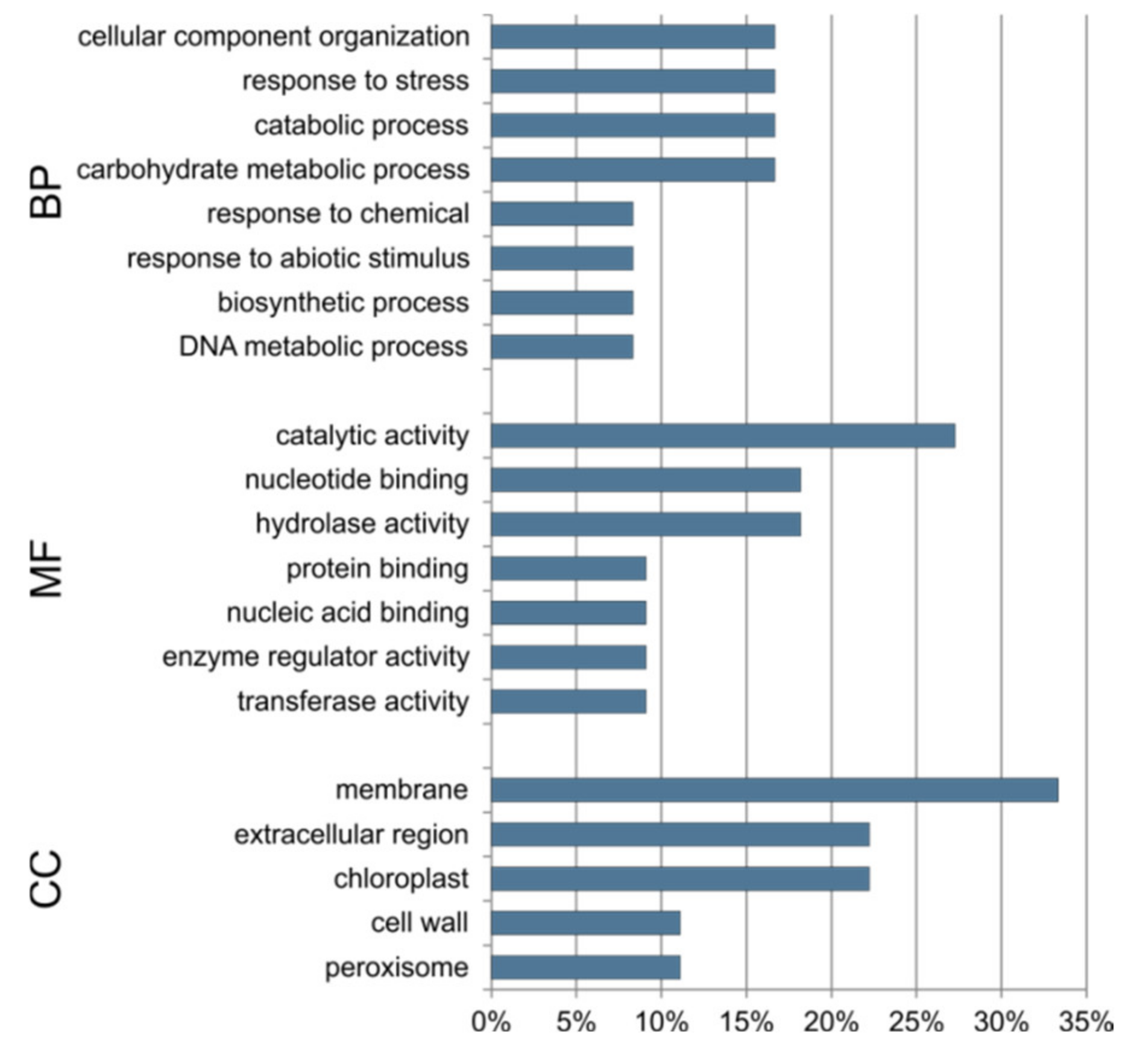

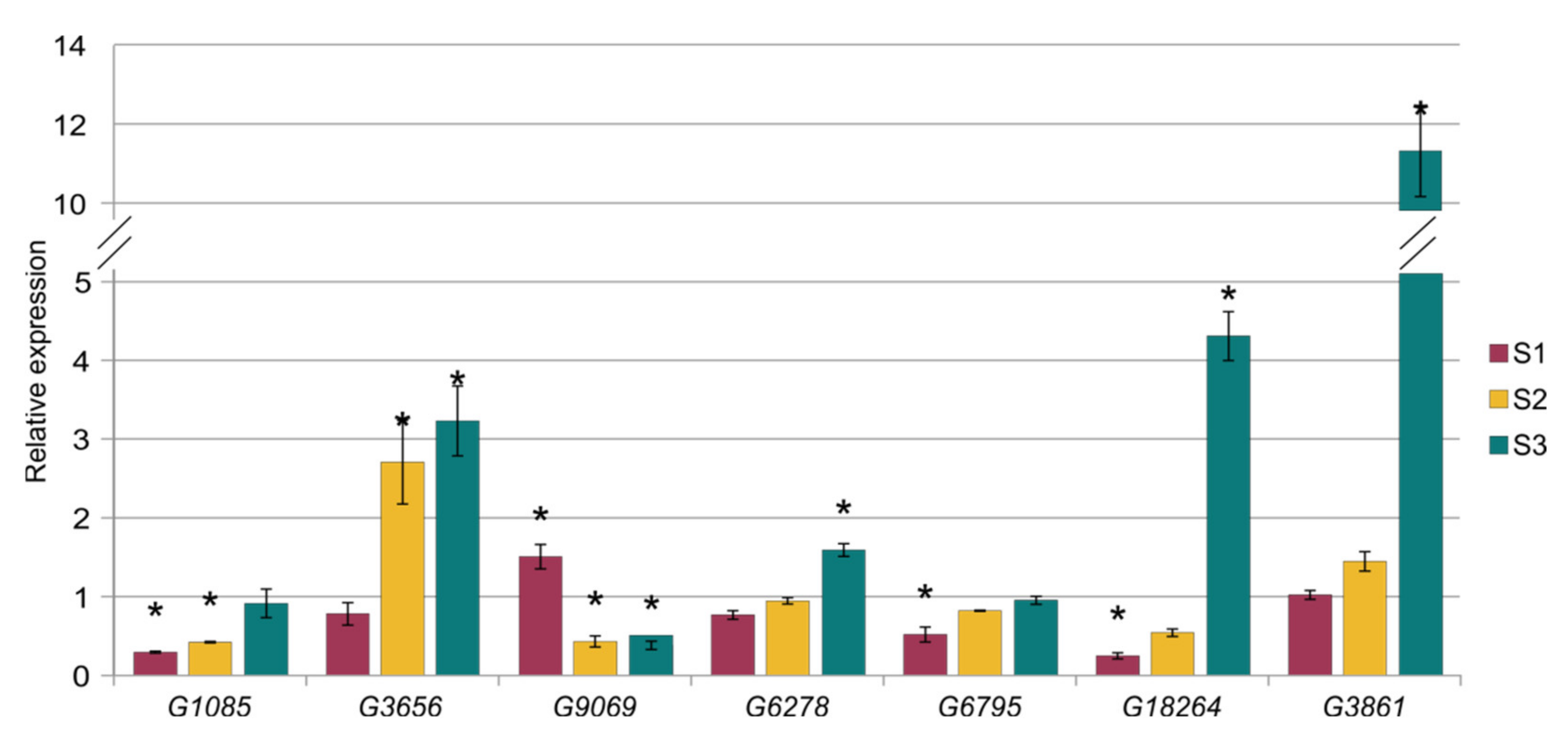
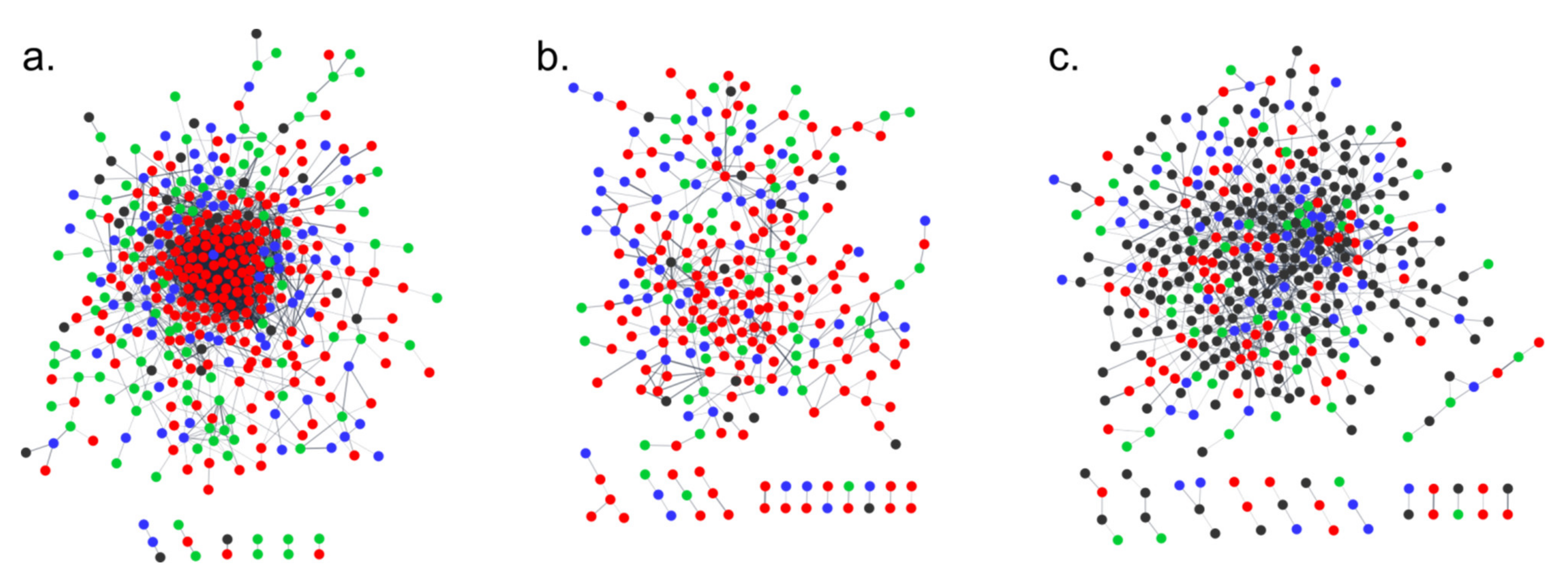
| Name | No of Reads | No of Bases | Average Quality | No of Redundant Reads | No of Non-Redundant Reads |
|---|---|---|---|---|---|
| B10-1 replica 1 | 54,414,580 | 2,720,729,000 | 37 | 49,609,519 | 10,631,119 |
| B10-1 replica 2 | 52,662,855 | 2,633,142,750 | 38 | 47,499,178 | 10,183,587 |
| B10-1 replica 3 | 53,443,079 | 2,672,153,950 | 37 | 49,140,803 | 10,609,010 |
| S1 replica 1 | 59,957,197 | 2,997,859,850 | 37 | 56,996,268 | 12,906,453 |
| S1 replica 2 | 65,970,225 | 3,298,511,250 | 37 | 61,387,885 | 13,627,221 |
| S1 replica 3 | 55,958,724 | 2,797,936,200 | 38 | 50,632,900 | 10,480,173 |
| S2 replica 1 | 54,754,145 | 2,737,707,250 | 37 | 50,586,963 | 10,037,716 |
| S2 replica 2 | 55,012,115 | 2,750,605,750 | 37 | 51,853,481 | 12,727,260 |
| S2 replica 3 | 63,929,895 | 3,196,494,750 | 37 | 60,299,086 | 11,541,983 |
| S3 replica 1 | 54,014,273 | 2,700,713,650 | 37 | 49,956,937 | 12,497,879 |
| S3 replica 2 | 57,712,663 | 2,885,633,150 | 37 | 52,286,044 | 11,925,631 |
| S3 replica 3 | 54,880,025 | 2,744,001,250 | 37 | 51,545,852 | 12,237,325 |
| ID | log2FC | Adj. p Value | Expression | Line |
|---|---|---|---|---|
| cst-novel-miR114 | −1.803 | 3.37 × 10–2 | down | S1 |
| ath-miR393a-3p | 1.039 | 4.61 × 10–2 | up | S1 |
| cst-novel-miR414 | 1.238 | 4.32 × 10–6 | up | S1 |
| cst-novel-miR403 | 1.395 | 2.07 × 10–3 | up | S1 |
| cst-novel-miR400 | 1.740 | 2.53 × 10–4 | up | S1 |
| cst-novel-miR436 | 1.811 | 4.70 × 10–6 | up | S1 |
| cst-novel-miR246 | 2.114 | 1.04 × 10–3 | up | S1 |
| cst-novel-miR229 | 4.011 | 9.62 × 10–12 | up | S1 |
| cst-novel-miR486 | −3.227 | 4.66 × 10–5 | down | S2 |
| cme-MIR169l | −3.184 | 4.66 × 10–5 | down | S2 |
| cst-novel-miR196.2 | −2.677 | 4.96 × 10–3 | down | S2 |
| cst-novel-miR356 | −2.672 | 3.08 × 10–3 | down | S2 |
| cst-novel-miR320 | −2.291 | 4.72 × 10–6 | down | S2 |
| cme-MIR167c | 1.140 | 3.08 × 10–3 | up | S2 |
| cme-MIR394a | 1.150 | 3.09 × 10–5 | up | S2 |
| ath-miR393a-3p | 1.623 | 2.25 × 10–5 | up | S2 |
| cme-MIR171e | 2.560 | 2.72 × 10–4 | up | S2 |
| cst-novel-miR377 | 3.790 | 1.01 × 10–10 | up | S2 |
| cst-novel-miR153 | −5.474 | 1.65 × 10–8 | down | S3 |
| cst-novel-miR196.2 | −4.543 | 1.92 × 10–5 | down | S3 |
| cme-MIR169l | −4.350 | 1.23 × 10–8 | down | S3 |
| cst-novel-miR486 | −4.304 | 8.98 × 10–5 | down | S3 |
| cst-novel-miR222 | −3.946 | 7.18 × 10–3 | down | S3 |
| cst-novel-miR438 | −3.945 | 7.18 × 10–3 | down | S3 |
| cst-novel-miR114 | −3.827 | 8.94 × 10–3 | down | S3 |
| cst-novel-miR261 | −3.775 | 1.06 × 10–2 | down | S3 |
| cst-novel-miR356 | −3.668 | 1.54 × 10–4 | down | S3 |
| cst-novel-miR319 | −3.320 | 3.90 × 10–2 | down | S3 |
| cst-novel-miR394 | −3.210 | 4.61 × 10–2 | down | S3 |
| cst-novel-miR377 | −3.207 | 4.61 × 10–2 | down | S3 |
| cst-novel-miR274 | −2.680 | 7.30 × 10–3 | down | S3 |
| cst-novel-miR39 | −2.662 | 4.61 × 10–2 | down | S3 |
| cst-novel-miR280 | −2.152 | 4.38 × 10–2 | down | S3 |
| cme-MIR156b | −1.996 | 1.96 × 10–3 | down | S3 |
| cst-novel-miR94 | −1.925 | 1.67 × 10–2 | down | S3 |
| cst-novel-miR346 | −1.694 | 2.12 × 10–4 | down | S3 |
| cst-novel-miR156 | −1.694 | 2.84 × 10–2 | down | S3 |
| cst-novel-miR195.2 | −1.597 | 4.61 × 10–3 | down | S3 |
| cst-novel-miR104 | −1.575 | 4.52 × 10–2 | down | S3 |
| cst-novel-miR242 | −1.550 | 1.87 × 10–4 | down | S3 |
| cst-novel-miR167 | −1.463 | 1.06 × 10–2 | down | S3 |
| cst-novel-miR452 | −1.257 | 2.73 × 10–2 | down | S3 |
| cst-novel-miR9 | −1.051 | 3.82 × 10–2 | down | S3 |
| cst-novel-miR149 | 1.120 | 7.88 × 10–3 | up | S3 |
| ath-miR393a-3p | 1.171 | 7.88 × 10–3 | up | S3 |
| cst-novel-miR5.2 | 1.186 | 6.35 × 10–3 | up | S3 |
| cst-novel-miR26 | 1.423 | 4.61 × 10–2 | up | S3 |
| cme-MIR166b | 1.674 | 1.79 × 10–5 | up | S3 |
| cst-novel-miR138 | 1.700 | 8.01 × 10–4 | up | S3 |
| cme-MIR396e | 1.717 | 1.67 × 10–2 | up | S3 |
| cst-novel-miR358 | 1.760 | 1.08 × 10–3 | up | S3 |
| cme-miR164b | 1.804 | 1.07 × 10–5 | up | S3 |
| cst-novel-miR113.2 | 1.810 | 1.67 × 10–2 | up | S3 |
| cst-novel-miR444.3 | 1.866 | 4.61 × 10–2 | up | S3 |
| cst-novel-miR120 | 1.912 | 4.61 × 10–2 | up | S3 |
| cme-MIR390d | 2.323 | 4.13 × 10–4 | up | S3 |
| cme-MIR169f | 4.171 | 9.86 × 10–11 | up | S3 |
| cst-novel-miR207 | 4.356 | 1.34 × 10–5 | up | S3 |
| cst-novel-miR394.2 | 5.011 | 1.02 × 10–8 | up | S3 |
| cst-novel-miR318 | 5.495 | 1.92 × 10–5 | up | S3 |
| cst-novel-miR19 | 5.697 | 1.07 × 10–5 | up | S3 |
| cst-novel-miR441 | 7.069 | 2.86 × 10–10 | up | S3 |
| Target | Biotype | Description | miRNA | ||
|---|---|---|---|---|---|
| S1 | S2 | S3 | |||
| G1085 | protein_coding | cytochrome P450 | ath-miR393a-3p C | ||
| G10994 | protein_coding | peroxisome biogenesis protein | ath-miR393a-3p C | ||
| G15867 | protein_coding | peroxisome biogenesis protein | ath-miR393a-3p C | ||
| G16626 | protein_coding | chaperone protein | ath-miR393a-3p C | ||
| G2235 | protein_coding | OTU domain-containing protein | ath-miR393a-3p C | ||
| G2374 | protein_coding | Putative methyltransferase | ath-miR393a-3p C | ||
| G2520 | protein_coding | CAS1 domain-containing protein | ath-miR393a-3p C | ||
| G3656 | protein_coding | pectinesterase | ath-miR393a-3p C | ||
| G5603 | protein_coding | NADH dehydrogenase-like | ath-miR393a-3p C | ||
| G6384 | protein_coding | GYF domain-containing protein | ath-miR393a-3p C | ||
| miRNA | Target | log2FC | Adj. p Val. | Description | Line |
|---|---|---|---|---|---|
| cst-novel-miR114 | G17365.T39 C | −1.92 | 4.68 × 10–3 | EamA-like transporter family | S1 |
| ath-miR393a-3p | G16626.T6 | 0.73 | 3.86 × 10–2 | chaperone protein | S1 |
| ath-miR393a-3p | G2374.T7 C | 1.82 | 1.02 × 10–6 | Putative methyltransferase | S1 |
| cst-novel-miR246 | G5022.T1 C | 2.15 | 2.80 × 10–2 | flavin-containing monooxygenase | S1 |
| ath-miR393a-3p | G3656.T2 C | 1.66 | 1.65 × 10–2 | pectinesterase | S2 |
| cme-MIR396e | G10545.T4 C | −0.73 | 1.82 × 10–3 | CW-type Zinc Finger | F-Box protein | S3 |
| cme-MIR396e | G10545.T5 C | −0.75 | 2.61 × 10–2 | CW-type Zinc Finger | F-Box protein | S3 |
| cst-novel-miR113-2 | G13161.T1 C | −1.90 | 2.46 × 10–2 | Squamosa promoter-binding-like protein | S3 |
| cme-MIR166b | G13471.T1 T | −0.90 | 4.11 × 10–2 | protein brittle-1, chloroplastic | S3 |
| cst-novel-miR358 | G15151.T1 C | 1.48 | 3.37 × 10–2 | unknown | S3 |
| cme-MIR390d | G18807.T10 C | −4.09 | 4.72 × 10–6 | zinc finger C3HC4 type family protein | S3 |
| cme-MIR390d | G18807.T14 C | −2.11 | 4.86 × 10–3 | zinc finger C3HC4 type family protein | S3 |
| cme-MIR390d | G18807.T24 C | −1.33 | 1.83 × 10–2 | zinc finger C3HC4 type family protein | S3 |
| cme-MIR390d | G18807.T35 C | 1.38 | 1.39 × 10–2 | zinc finger C3HC4 type family protein | S3 |
| cme-MIR390d | G18807.T43 C | 1.84 | 4.44 × 10–4 | zinc finger C3HC4 type family protein | S3 |
| cme-MIR390d | G18807.T53 C | 1.45 | 8.43 × 10–4 | zinc finger C3HC4 type family protein | S3 |
| cme-MIR390d | G18807.T61 C | 1.44 | 3.40 × 10–3 | zinc finger C3HC4 type family protein | S3 |
| cme-MIR390d | G18807.T9 C | 2.66 | 5.22 × 10–3 | zinc finger C3HC4 type family protein | S3 |
| cst-novel-miR120 | G19248.T1 T | −0.66 | 1.66 × 10–2 | BRCA1 C Terminus (BRCT) domain | S3 |
| cst-novel-miR120 | G20176.T1 T | 6.68 | 4.36 × 10–21 | unknown | S3 |
| cst-novel-miR120 | G20340.T1 T | −8.16 | 3.74 × 10–5 | unknown | S3 |
| ath-miR393a-3p | G2374.T7 C | 0.98 | 1.14 × 10–2 | Putative methyltransferase | S3 |
| cst-novel-miR452 | G3070.T15 C | −4.03 | 1.02 × 10–12 | Inherit from NOG: expressed protein | S3 |
| cst-novel-miR452 | G3070.T17 C | −2.27 | 3.06 × 10–2 | expressed protein | S3 |
| cst-novel-miR452 | G3070.T2 C | −2.18 | 4.61 × 10–9 | Inherit from NOG: expressed protein | S3 |
| cst-novel-miR452 | G3070.T26 C | −3.10 | 4.11 × 10–2 | expressed protein | S3 |
| cst-novel-miR452 | G3070.T28 C | −1.90 | 3.99 × 10–7 | Inherit from NOG: expressed protein | S3 |
| ath-miR393a-3p | G3656.T1 C | 1.90 | 1.37 × 10–2 | pectinesterase | S3 |
| ath-miR393a-3p | G3656.T2 C | 2.00 | 9.79 × 10–4 | pectinesterase | S3 |
| cst-novel-miR120 | G5265.T9 T | 4.97 | 7.83 × 10–8 | unknown | S3 |
| cst-novel-miR26 | G6017.T3 C | 0.48 | 4.29 × 10–2 | unknown | S3 |
| cst-novel-miR26 | G6017.T4 C | 0.88 | 4.75 × 10–2 | unknown | S3 |
| cst-novel-miR26 | G6017.T8 C | 0.78 | 4.30 × 10–2 | unknown | S3 |
| cst-novel-miR26 | G6017.T9 C | 0.66 | 1.84 × 10–2 | unknown | S3 |
| cst-novel-miR5-2 | G8545.T1 C | −1.78 | 2.55 × 10–6 | NAC domain-containing protein | S3 |
| cst-novel-miR94 | G8689.T23 C | 0.79 | 1.72 × 10–2 | Ca-transport ATPase 9, plasma membrane | S3 |
| cst-novel-miR94 | G8689.T26 C | 0.85 | 1.19 × 10–2 | Ca-transport ATPase 9, plasma membrane | S3 |
| cst-novel-miR94 | G8689.T35 C | 0.66 | 1.92 × 10–2 | Ca-transport ATPase 9, plasma membrane | S3 |
| cst-novel-miR113-2 | G8943.T2 C | 2.73 | 1.64 × 10–2 | squamosa | S3 |
| cst-novel-miR5-2 | G9069.T2 C | −3.01 | 6.62 × 10–3 | Protein CUP-SHAPED COTYLEDON | S3 |
Publisher’s Note: MDPI stays neutral with regard to jurisdictional claims in published maps and institutional affiliations. |
© 2022 by the authors. Licensee MDPI, Basel, Switzerland. This article is an open access article distributed under the terms and conditions of the Creative Commons Attribution (CC BY) license (https://creativecommons.org/licenses/by/4.0/).
Share and Cite
Pawełkowicz, M.E.; Skarzyńska, A.; Koter, M.D.; Turek, S.; Pląder, W. miRNA Profiling and Its Role in Multi-Omics Regulatory Networks Connected with Somaclonal Variation in Cucumber (Cucumis sativus L.). Int. J. Mol. Sci. 2022, 23, 4317. https://doi.org/10.3390/ijms23084317
Pawełkowicz ME, Skarzyńska A, Koter MD, Turek S, Pląder W. miRNA Profiling and Its Role in Multi-Omics Regulatory Networks Connected with Somaclonal Variation in Cucumber (Cucumis sativus L.). International Journal of Molecular Sciences. 2022; 23(8):4317. https://doi.org/10.3390/ijms23084317
Chicago/Turabian StylePawełkowicz, Magdalena Ewa, Agnieszka Skarzyńska, Marek Daniel Koter, Szymon Turek, and Wojciech Pląder. 2022. "miRNA Profiling and Its Role in Multi-Omics Regulatory Networks Connected with Somaclonal Variation in Cucumber (Cucumis sativus L.)" International Journal of Molecular Sciences 23, no. 8: 4317. https://doi.org/10.3390/ijms23084317
APA StylePawełkowicz, M. E., Skarzyńska, A., Koter, M. D., Turek, S., & Pląder, W. (2022). miRNA Profiling and Its Role in Multi-Omics Regulatory Networks Connected with Somaclonal Variation in Cucumber (Cucumis sativus L.). International Journal of Molecular Sciences, 23(8), 4317. https://doi.org/10.3390/ijms23084317






